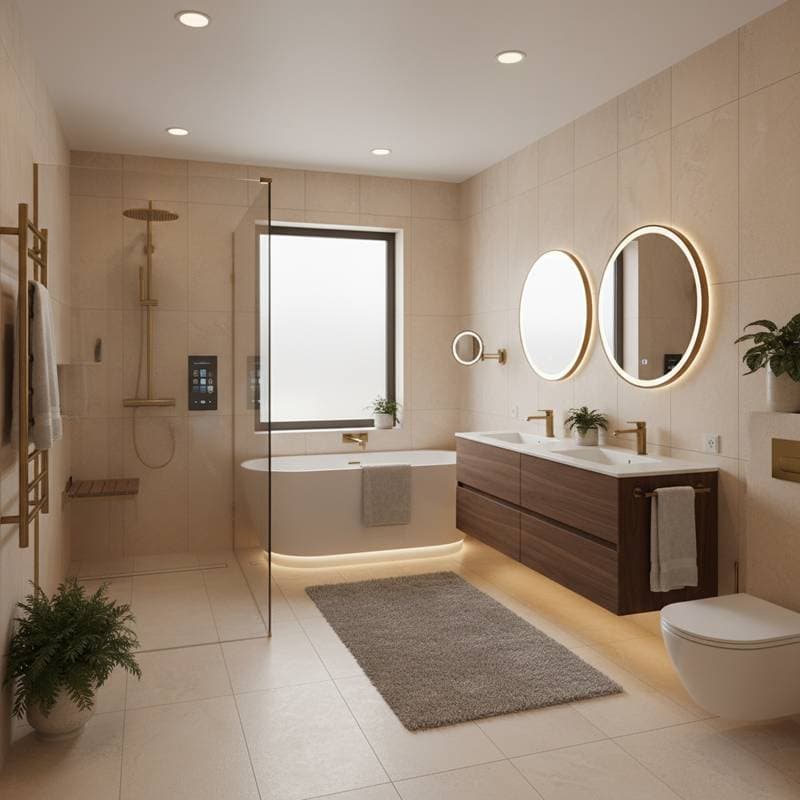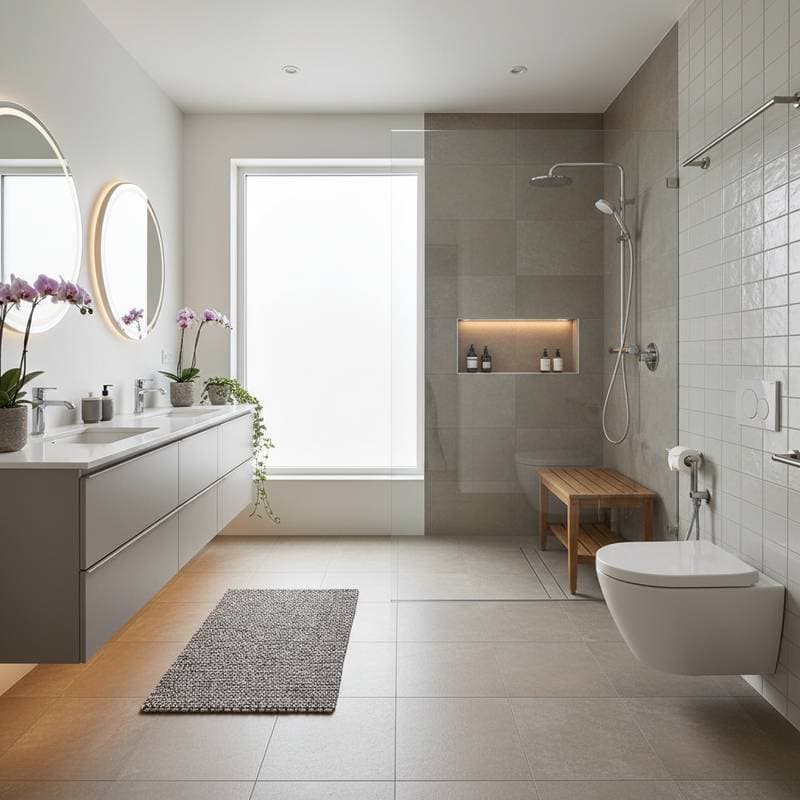Japandi Wet Rooms: Why They Define 2025 Bathroom Design
Japandi wet rooms combine Scandinavian minimalism with Japanese tranquility to create serene, functional bathrooms. This design approach emphasizes clean lines, natural materials, and purposeful spaces that evoke a spa-like atmosphere. Suitable for various budgets, these rooms transform daily routines into experiences of balance and well-being.
Defining Features of Japandi Wet Rooms
Japandi design achieves harmony through simplicity and authenticity. In wet rooms, this translates to open layouts without barriers, allowing seamless movement and reduced visual clutter. The absence of traditional shower enclosures, replaced by gently sloped floors and integrated drainage, enhances both aesthetics and practicality.
Wet rooms align perfectly with Japandi principles by promoting fluidity between wet and dry zones. Materials such as wood and stone provide warmth, while the overall design ensures durability in humid environments. This setup supports effortless maintenance and a sense of spaciousness, even in compact areas.
Essential Components of Japandi Wet Rooms
Achieving the Japandi aesthetic requires careful selection of materials, colors, and fixtures. The following elements form the foundation of this style:
-
Natural Materials
Incorporate elements like light oak for shelving, bamboo for accents, and porcelain tiles that replicate stone. These choices ground the space in organic textures, fostering a connection to nature without overwhelming the minimal framework. -
Neutral Color Schemes
Opt for palettes featuring soft beiges, grays, and whites, with occasional subtle accents in sage green or pale pink. Such tones promote calm and unity, avoiding bold contrasts that disrupt serenity. -
Matte Surface Finishes
Select matte tiles, brushed metal hardware, and honed stone surfaces to diffuse light gently. These finishes contribute to an understated elegance that feels approachable and timeless. -
Purposeful Minimalism
Integrate storage solutions like recessed cabinets or wall-hung vanities to maintain order. Fixtures should blend functionality with subtlety, ensuring every item contributes to the room's efficiency. -
Nature-Inspired Details
Introduce indoor plants, maximize natural light through frosted glass, and layer textures like linen or rattan. A single strategic plant placement can elevate the restorative quality of the space.
Implementing Japandi on Different Budgets
Japandi's versatility allows adaptation to various financial levels without compromising core principles. Focus on high-impact changes that prioritize quality over quantity.
Budget Under $500
Refresh walls with a neutral paint such as warm taupe or soft slate. Replace fabric elements with linen alternatives in earthy hues and add humidity-tolerant plants like Boston ferns. Incorporate affordable bamboo organizers for toiletries to enhance organization.
Budget $500 to $3,000
Update flooring with oversized porcelain tiles mimicking limestone for a seamless look. Install a fixed rainfall showerhead in matte nickel and add slim LED under-cabinet lighting. Consider a floating oak vanity to introduce wood elements without major plumbing work.
Budget Over $3,000
Redesign the layout for a fully open wet room using continuous microcement flooring. Incorporate underfloor heating and custom walnut cabinetry for added luxury. Source authentic materials like reclaimed wood accents to achieve depth and character.
Each tier builds toward the same serene outcome, emphasizing thoughtful selections that align with personal needs.
Insights from Professional Design Projects
Experience from high-profile renovations reveals that lighting and spatial flow determine a bathroom's success. In Japandi wet rooms, diffused natural light interacts with matte surfaces to create inviting depth. Layouts that prioritize open sightlines amplify this effect, making the space feel larger and more harmonious.
Rapid transformations in design projects highlight Japandi's efficiency. Applying a durable mineral-based paint, strategic accessory placement, and simplified tiling can refresh a room dramatically. These techniques apply equally to residential settings, offering substantial improvements with minimal disruption.
Advances in Materials for Japandi Wet Rooms
Recent material innovations enhance the feasibility of Japandi designs. Microcement provides a monolithic, waterproof surface resembling polished concrete, ideal for walls and floors in wet areas. Its resistance to slips and ease of application make it a practical choice for modern bathrooms.
Advanced porcelain options emulate artisanal clay or wood grains, delivering visual interest with low upkeep. For wood integration, select moisture-resistant engineered panels treated with sealants. These maintain the desired warmth while ensuring longevity in damp conditions.
Drainage solutions have also improved, with linear channels positioned discreetly to preserve floor continuity. Such systems support the seamless aesthetic while optimizing water flow, contributing to both form and function.
Practical Styling for Daily Use
Styling a Japandi wet room involves layering subtle elements that enhance usability. Fold organic cotton towels in neutral shades and arrange them on open wood shelves for accessibility. Store essentials in clear glass containers to maintain visibility and order.
Limit decorative items to essentials, such as a ceramic vessel for soaps or a single sculptural element. Adjustable lighting, including sconces with warm bulbs, allows mood adaptation from morning preparation to evening relaxation. Consistent organization ensures the space remains a sanctuary amid routine.
Benefits of Integrating Japandi into Your Routine
A Japandi wet room extends beyond aesthetics to support daily well-being. The streamlined design simplifies cleaning, while natural elements promote relaxation during use. Over time, this environment fosters mindfulness, turning mundane tasks into rejuvenating rituals.
For homeowners considering resale, the style offers broad appeal through its blend of modernity and endurance. Potential buyers appreciate bathrooms that balance luxury with practicality, increasing property value.
Steps to Achieve Your Japandi Wet Room
Begin by assessing your current space and identifying priority areas, such as updating fixtures or introducing natural textures. Compile a mood board with images of desired materials and layouts to guide decisions. Establish a budget that accommodates essential upgrades while allowing flexibility.
Consult professionals for structural changes like drainage modifications to ensure safety and compliance. Proceed incrementally to minimize inconvenience, starting with cosmetic enhancements. The result will be a personalized retreat that enhances your home's tranquility.








